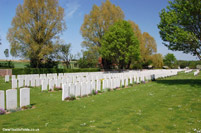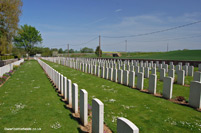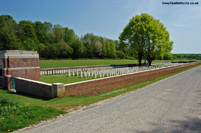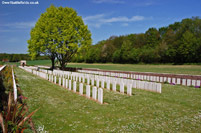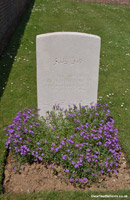Becourt
The World War One Battlefields site is undergoing a major update, with pages being converted to a new, user-friendly mobile format. The updated pages can be found at Updated World War One Battlefields. Some pages such as this one remain in the original format pending update.
I have added this page mainly to cover two very interesting cemeteries, one found on the outskirts of the small village of Becourt, and the other in the nearby village of Becordel-Becourt. These villages are just under two miles east of Albert itself, with Becordel-Becourt reached first by following the road which leads from Albert towards Fricourt.
These villages were behind the lines for the Battle of the Somme in 1916, and were important areas during that time as well as before. Becordel-Becourt was the location of a large artillery depot, and many troops bivouacked here as they made their way up the lines. The village lies in a valley, and so was protected from the lines near Fricourt to the east by the contours of the land. Because of this, it was also an area used by the medical facilities of the Army; the 14th Field Ambulance were based here for the start of the Battle of the Somme with other Field Ambulance units being sited here later during the battles, and there were also Advanced Dressing Stations (ADS) here as well.
Dartmoor Cemetery
Dartmoor Cemetery is to the north-east of the village, and was started by battalions of the Fifth Division in August 1915. Originally known as Becordel-Becourt Military Cemetery, the name was changed to Dartmoor Cemetery at the request of the 8th and 9th battalions of the Devonshire Regiment in May 1916. The majority of the burials here date from 1916; there are a few from 1915, very few from 1917 and 1918.
Set a little away from the village, this is a peaceful spot, and there are many interesting graves within the cemetery. One is the grave of a man who is the oldest known battle death of the Geat War: Lieutenant Harry Webber who died of wounds on the 21st of July 1916. The online CWGC records list him as aged 67, but in the register he is described as 68 years old. He was also Mentioned in Dispatches, and the register records that he was a member of the Stock Exchange for 40 years. In 1901 he was living at The Elms in Horley with six daughters, one son and six servants. His son, also Henry, was then serving as an officer in the Militia.
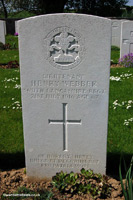
The grave of Henry Webber, the oldest known battle casualty of the Great War
Henry Webber is one of the soldiers followed in Martin Middlebrook's The First Day on the Somme, in which he is also described as aged 68. Middlebrook gives some further information on how he died; as Transport Officer for the 7th South Lancashires he took up supplies to the battalion near Mametz Wood on the evening of the 21st of July 1916. One German shell fell among a group of men who stood talking, and although not killed outright, Henry Webber died of his wounds that same evening. His age meant that his death attracted special atention with his family receiving messags of sympathy from the King and Queen and the Army Council.
Also buried here are a father and son, who lie side by side in Plot 1 Row A. They are 44 year old Serjeant George Lee and 19 year old Corporal Robert Lee. Both served with 'A' Battery of the 156th Brigade of the Royal Field Artillery, and both died in the same incident on the 5th of September 1916. One can only imagine the terrible news for the family in Peckham, with Frances Lee losing a husband and son on the same day.
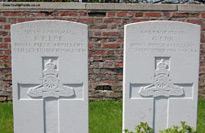
The graves of George and Robert Lee, father and son, killed on the same day
A Victoria Cross winner is also buried in Dartmoor Cemetery - Private James Miller of the 7th King's Own (Royal Lancaster) Regiment. He was aged 26 when he died on the 30th of July 1916, winning the VC for his actions that day in ensuring that a vital message was delivered. His battalion had captured a position and was consolidating. James Miller was ordered to take a message back although the way was subject to heavy enemy shell and rifle fire, and to bring back an answer at all costs. He had to cross open ground, and on leaving the captured trench was shot in the back, the bullet exiting through his abdomen. He pressed his hand against the wound, reached his destination, delivered the message and also returned to his oiginal position with the answer. Once he delivered this to his oficer, he finally succumbed to his wound and died. This not only highlights the supreme courage of this particular man, but also reminds us of the very real problems with commnications in the Great War. Without men like James Miller carrying messages back and forth under fire there would have been no update on the progress of the battle, no sending of reinforcements or supplies to where they were desperately needed and although men often died carrying these messages, in the days before radio commnications there was really no alternative. Many other lives may have been saved on this occasion because the messages carried by James Miller got through.
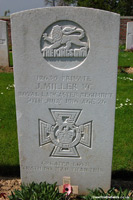
The grave of VC winner, James Miller
Every grave in every Great War cemetery, whether a VC winner or not has a tale to tell. In Plot 1, Row A, is the grave of Private Frank Columbell of the 10th King's Liverpool Regiment. Frank died on the 9th of Sepember 1916, aged 26. Beside his headstone is a stone tablet which records that his brother Alec visited the grave on the 1st of August 1953. Although the cemetery register records that the family were from Loughborough, the tablet shows that Alec came from the other side of the world, Australia, to visit the grave of his brother 37 years after he died.
The headstone of Private Henry Reece of the Royal Fusiliers who died ten days before Christmas 1915 bears a simple but poignant inscription: 'God Bless our Daddy. Till we meet again. Amen'.
Norfolk Cemetery
Norfolk Cemetery is found by following the small road that leads north from Dartmoor Cemetery across the main road. The cemetery is on the right side of the road after about half a mile. It is just to the south of the tiny village of Becourt, where the Chateau was used as headquarters by various battalions and brigades during their time here. It was also used as a dressing station. A trench called Middlesex Avenue used to run very near the cemetery on the same side of the road and parrallel with it, and looking to the right across the cemetery, trenches ran up towards the front lines which were east of here.
The cemetery was begun by the 1st Norfolks (hence its name) in August 1915. By the Armistice there were around 280 graves, with a further 268 graves concentrated here later. As the photos above show, there are five main rows of graves here. Most face away from the road,although the row furthest from the road faces towards it. One single grave set by itself near the road is that of an Indian soldier, Noor Mohammed (spelt Nur in the register) of Hodson's Horse who died on the 11th of August 1916. Hodson's Horse were a cavalry unit, their name coming from the old tradition where some units in the Army took on the name of their Commanders. Major William Hodson, son of the Canon of Lichfield, served in the 1800s and following his riding 152 miles with despatches in seventy-two hours the unit was named in his honour. He was killed during the relief of Lucknow in 1858, but a unit bearing his name survived for many years.
Major Stewart Walter Loudoun-Shand is a Victoria Cross winner buried in Norfolk Cemetery. He won the VC at Fricourt on the 1st of July 1916, when his unit, the 10th Yorkshires, were struggling to advance in the face of fierce German machine-gun fire. Loudon-Shand jumped up onto the parapet of the trench and helped and encouragd the men over it but was badly wounded. Despite this, he insisted on being propped up in trench and continued encouraging the men until he died.
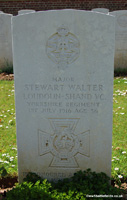
The grave of VC winner, Stewart Walter Loudoun-Shand
In Plot 1, Row A is buried Lieutenant Wolfred Cloutman of the 178th Tunneling Company, who died on the 21st of August 1915. He was Mentioned in Desptaches twice, and the register records that he was killed after rescuing a Serjeant who he caried 45 feet up a ladder from a mine. The Serjeant was taken from his shoulders as he reached the top, but exhausted and overcome by gas Cloutman fell back down the shaft. Gerald Gliddon in Somme 1916 records that the ashes of his brother, Major Brett Cloutman, the last VC receipient of the First World War in 1918, were placed in the grave alongside Wolfreds after Brett Cloutman died in 1971.
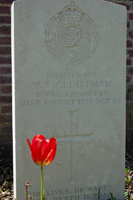
The grave of Lieutenant Cloutman
The inscriptions chosen by the families of those who died always have the power to move me. On the headstone of Gunner Walter Elvin, who served with a Trench Mortar Battery in the Royal Garison Artillery, and who died just before the Battle of the Somme aged 24, are the words 'Death divides but memory clings. From his broken-hearted Father, Sisters and Brothers'. William Tointon from Waltham Abbey in Essex died on the same day as Walter (the 28th of June 1916) aged 21 serving with the Middlesex Regiment. After the war his parents (probably his mother, Minnie) chose the words 'Dear Son I miss you as each day goes by. Your memory and loving face will never fade'. The inscription on Private Jack Handley's grave covers not only the loss, but thecourage of those who served. It reads 'Sadly missed by his sisters and brothers. He said "It's worth it"'.
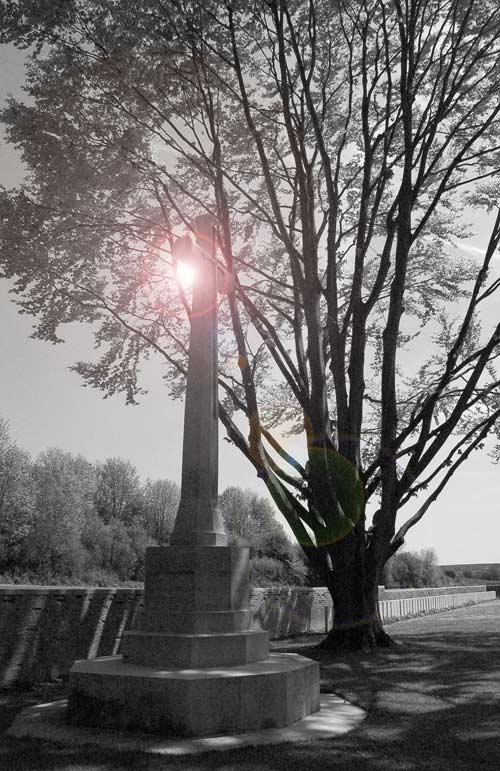
Norfolk Cemetery
Sources & Acknowledgements
Commonwealth War Graves Commission website
Gerald Gliddon : Somme 1916
Major & Mrs. Holt: Battlefield Guide to the Somme
Martin Middlebrook: The First Day on the Somme
Martin & Mary Middlebrook: Somme Battlefields
Jan Morris: Heaven's Command
Paul Reed: Walking the Somme

